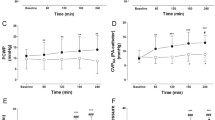Abstract
Coagulopathy and massive bleeding plays a major role in the mortality of thoracoabdominal aneurysm repair. Increasing supraceliac aortic cross-clamp time from 0 to 90 minutes increases the degree of disseminated intravascular coagulation, which occurs as a result of occlusion and reperfusion of the superior mesenteric artery. The purpose of this study was to investigate the mechanism of the superior mesenteric artery reperfusion disseminated intravascular coagulation. Twenty dogs were divided into four groups: cross-clamp time of 30 minutes; cross-clamp time of 60 minutes; cross-clamp time of 90 minutes; and control. Permeability was determined by lactulose/mannitol absorption. The venous effluent was sampled for endotoxin, potassium, bacteria, and pH every hour and urine was collected for six hours. Lactulose absorption was significantly higher in all of the experimental groups. There was increased permeability in the 60 and 90 minute groups which correlated significantly with time. Venous endotoxin, potassium, and blood cultures for bacteria did not change significantly. The pH was significantly lower every hour for six hours in the 90 minute group. These data suggest that intestinal permeability is increased with supraceliac aortic clamping and can be kept to a minimum for clamp times of under one hour.
Similar content being viewed by others
References
CRAWFORD ES, CRAWFORD JL, SAFI HJ, et al. Thoracoabdominal aortic aneurysms: preoperative and intraoperative factors determining immediate and long-term results of operations in 605 patients.J Vasc Surg 1986;3:389–404.
COHEN JR, ANGUS L, ASHER A, et al. Disseminated intravascular coagulation as a result of supraceliac clamping: implications for thoracoabdominal aneurysm repair.Ann Vasc Surg 1987;5:552–557.
COHEN JR, SCHRODER W, LEAL J, et al. Mesenteric shunting during thoracoabdominal aortic clamping to prevent disseminated intravascular coagulation in dogs.Ann Vasc Surg 1988;2(3:261–267.
DEITCH EA. Intestinal permeability is increased in burn patients shortly after injury.Surgery 1990;107(4:411–416.
BEHREN RH, DOCHERTY H, ELIA M, et al. A simple enzymatic method for the assay of urinary lactulose.Clinica Chimica Acta 1984;137:361–367.
CORCORAN AC, PAGE IH. A method for the determination of mannitol in plasma and urine.J Biol Chem 1947;170:165–171.
JONES WG II, MINEI JP, BARBER AE, et al. Bacterial translocation and intestinal atrophy after thermal injury and burn wound sepsis.Ann Surg 1990;211(4:399–405.
BAKER JW, DEITCH EA, BERG RD, et al. Hemorrhagic shock impairs the mucosal barrier, resulting in bacterial translocation from the gut and sepsis.Surg Forum 1987;38:73–74.
MAEJIMA K, DEITCH EA, BERG RD. Bacterial translocation from the gastrointestinal tracts of rats receiving thermal injury.Infect Immun 1984;43:6–13.
MORRIS SE, NAVARATNAM N, TOWNSEN CM, et al. Bacterial translocation and mesenteric blood flow in a large animal model after cutaneous thermal and smoke inhalation injury.Surg Forum 1988;39:189–190.
DEITCH EA, MA L, JING W, et al. Genetic susceptibility to mucosal damage leads to bacterial translocation in a murine burn model. Proceedings of the American Burn Association. Twenty-first Annual Meeting, 1989;21:239.
BOURCHIER RG, GLOVICZKI P, LARSON MV, et al. The mechanisms and prevention of intravascular fluid loss after occlusion of the supraceliac aorta in dogs.J Vasc Surg 1991:13(5:637–645.
Author information
Authors and Affiliations
About this article
Cite this article
Cohen, J.R., Sardari, F., Paul, J. et al. Increased intestinal permeability: Implications for thoracoabdominal aneurysm repair. Annals of Vascular Surgery 6, 433–437 (1992). https://doi.org/10.1007/BF02006998
Issue Date:
DOI: https://doi.org/10.1007/BF02006998




